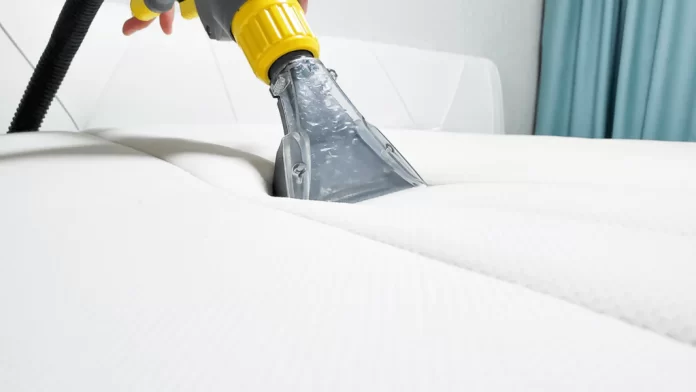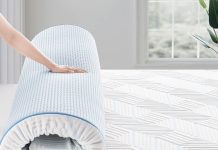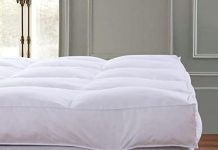This article will share some helpful tips on effectively cleaning mattress stains caused by body fluids. We understand that accidents happen, and removing these stubborn stains can be challenging. However, fear not! With our easy-to-follow techniques and simple ingredients, you can restore your mattress to its original cleanliness and freshness. Whether sweat, urine, or other bodily fluids, we’ve got you covered! Say goodbye to those unsightly stains and hello to a spotless and odor-free mattress.
Review contents
Understanding the Importance of Cleaning Mattress Stains
Maintaining our mattresses’ cleanliness is crucial for hygiene and health. We spend a lot of time in our beds, and any stains left unattended can become breeding grounds for bacteria, dust mites, and allergens. Regularly removing and cleaning stains can ensure a clean and healthy sleeping environment.
In addition to promoting hygiene and health, cleaning mattress stains also helps prolong our mattresses’ lifespan. Stains can seep deep into the mattress fabric, causing it to deteriorate over time. By properly cleaning and treating stains, we can prevent them from becoming permanent and extend our mattresses’ overall durability and lifespan.
Preventing Mattress Stains
Prevention is always better than cure; the same applies to mattress stains. Taking a few simple precautions can significantly reduce the chances of stains forming on our mattresses.
Using Mattress Protectors
One effective way to prevent mattress stains is by using a mattress protector. A good-quality mattress protector is a barrier between our bodies and the mattress, preventing spills or accidents from seeping through. Choosing a waterproof and breathable mattress protector that can be easily removed and washed is advisable.
Avoiding Eating or Drinking on the Bed
We all love the convenience of having a snack or a beverage in bed, but doing so increases the risk of accidental spills. Keeping food and drinks away from the bed is best to avoid any potential stains. If consuming meals or drinks in bed is unavoidable, trays or placemats can help minimize the chance of spills.
Taking Precautions during Intimate Activities
Intimate activities can sometimes result in stains on the mattress. To prevent this, placing towels or a waterproof sheet on the bed can protect the mattress from any potential fluids. Washing the bedding immediately after such activities is essential to avoid any lingering stains or odors.
Identifying Different Types of Body Fluid Stains
Body fluid stains can vary in their composition and require specific cleaning methods. It is crucial to accurately identify the type of stain to choose the appropriate cleaning solution. Here are the most common types of body fluid stains found on mattresses:
Blood Stains
Blood stains are common and can happen for various reasons, such as accidents, menstruation, or nosebleeds. To clean blood stains, it is essential to act quickly. Begin by blotting the stain gently with a clean cloth or towel to remove excess blood. Then, gently dab the stain with a mixture of cold water and mild dish soap. Avoid using hot water as it can set the stain. Continue blotting until the stain is no longer visible.
Urine Stains
Accidental bedwetting or spills can lead to urine stains on the mattress. Start by blotting the urine stain with a clean cloth or towel to remove as much liquid as possible. Next, create a solution using equal parts of water and white vinegar. Apply the solution to the stain and let it sit for a few minutes. Blot the stain again and repeat until the odor and stain are gone. Finally, sprinkle baking soda on the mattress surface, let it sit for a few hours, and vacuum it to remove any remaining odor.
Sweat Stains
Sweat stains are common, especially in warmer climates or during physical exertion. To remove sweat stains, begin by blotting the stained area with a clean cloth or towel. Then, mix equal parts of hydrogen peroxide and water and gently dab the stain with the solution. Remembering that hydrogen peroxide can bleach fabrics is important, so it is advisable to test it on a small, inconspicuous area first. Once the stain is gone, rinse the area with water and blot it dry.
Vomit Stains
Vomit stains can be challenging to clean due to the odor and potential for bacteria growth. Start by removing any solid chunks of vomit with a spoon or scraper. Next, blot the affected area with a clean cloth or towel to remove excess moisture. Mix a solution of one part water and one part white vinegar and lightly sponge the stain. Blot the area again with a clean cloth or towel, and if necessary, repeat the process until the stain and odor are eliminated. Finish by deodorizing the mattress using baking soda or a commercial odor eliminator.
Tools and Materials Required for Cleaning
We will need a few essential tools and materials to clean mattress stains effectively. Gathering these beforehand will ensure a smooth and efficient cleaning process. Here are the items you will need:
Cleaning Solutions
Appropriate cleaning solutions are essential for removing different types of mattress stains. Mild dish soap, white vinegar, hydrogen peroxide, and enzyme cleaners are some of the commonly used solutions.
White Vinegar
White vinegar is a versatile and inexpensive cleaning agent that can be used for various household cleaning tasks. It is particularly effective in eliminating odors and breaking down stains.
Baking Soda
Baking soda is an excellent natural cleaner and deodorizer. It helps absorb odors and can freshen up the mattress after cleaning.
Hydrogen Peroxide
Hydrogen peroxide is a powerful stain remover, especially for organic stains like blood or urine. It helps break down the stain and remove any lingering odors.
Clean Cloth or Towel
A clean cloth or towel is crucial for blotting and absorbing excess moisture or fluids from the mattress during cleaning. It should be absorbent and preferably made of a soft material.
Soft-Bristle Brush
A soft-bristle brush can gently agitate the cleaning solution and help remove stubborn stains from the mattress fabric without causing damage.
Step-by-Step Guide: How to Clean Mattress Stains from Body Fluids
Now that we have all the necessary tools and materials let’s dive into the step-by-step process of cleaning mattress stains from body fluids. Follow these instructions to remove stains and restore the cleanliness of your mattress effectively:
1. Prepare the Mattress
Start by removing any bedding or mattress covers and take them for washing separately. Vacuum the mattress surface thoroughly to remove loose debris, dust, or allergens.
2. Blotting and Absorbing Excess Fluid
For fresh stains, blot the affected area gently with a clean cloth or towel to absorb excess moisture. Avoid rubbing the stain, as it can push the fluids further into the mattress fabric.
3. Treating Blood Stains
Create a mixture of cold water and mild dish soap. Dab the blood stain with the solution using a clean cloth or towel. Continue blotting until the stain is no longer visible.
4. Treating Urine Stains
Blot the urine stain with a clean cloth or towel to remove as much liquid as possible. Mix equal water and white vinegar and apply the solution to the stain. Let it sit for a few minutes, then blot the stain again. Repeat the process until the odor and stain are gone. Sprinkle baking soda on the mattress surface, let it sit for a few hours, and vacuum it to remove any remaining odor.
5. Treating Sweat Stains
Blot the sweat stain with a clean cloth or towel. Mix equal hydrogen peroxide and water and gently dab the stain with the solution. Rinse the area with water and blot it dry.
6. Treating Vomit Stains
Remove any solid vomit chunks with a spoon or scraper. Blot the area with a clean cloth or towel to remove excess moisture. Create a solution of one part water and one part white vinegar and lightly sponge the stain. Blot the area again and repeat if necessary. Finish by deodorizing the mattress with baking soda or a commercial odor eliminator.
7. Deodorizing the Mattress
After treating the stains, sprinkle baking soda liberally over the entire mattress surface. Let it sit for several hours or overnight to absorb any remaining odors. Vacuum the mattress thoroughly to remove the baking soda residue.
8. Drying and Protecting the Mattress
Ensure the mattress is completely dry before replacing any bedding or covers. Direct sunlight and good airflow can help speed up the drying process. Once dry, consider using a mattress protector to prevent future stains and protect the mattress against spills, allergens, and dust mites.
Alternative Methods for Tough Stains
In some cases, stubborn stains may require additional treatment methods. Here are a few alternative methods to consider for tough stains:
Using Enzyme Cleaners
Enzyme cleaners are specifically designed to break down organic stains and eliminate odors. Follow the instructions on the product label and apply the enzyme cleaner to the stain. Allow it to sit for the recommended time before blotting and rinsing.
Steam Cleaning
Steam cleaning is an effective method for deep cleaning mattresses. Using a handheld steam cleaner, apply steam across the surface of the mattress, paying extra attention to stained areas. The heat and moisture from the steam helps break down stains and kill bacteria. Allow the mattress to dry thoroughly before using it again.
Professional Cleaning Services
Consider hiring professional mattress cleaning services for severe stains or if you prefer not to clean the mattress yourself. These professionals have specialized equipment and expertise to clean and remove tough stains effectively.
Tips and Precautions for Cleaning Mattress Stains
Here are some helpful tips and precautions to keep in mind when cleaning mattress stains:
Act Quickly
Promptly attend to any stains to prevent them from setting and becoming more challenging to remove. The longer a stain sits, the more likely it becomes permanent.
Avoid Excessive Moisture
While it is crucial to remove stains and odors, excessive moisture can lead to mold and mildew growth. Use minimal amounts of cleaning solutions and ensure thorough drying after cleaning.
Test Cleaning Solutions
Before applying any cleaning solution, test it on a small, inconspicuous mattress area to ensure it does not cause discoloration or damage. This step is crucial when using bleach or hydrogen peroxide-based solutions.
Follow the Manufacturer’s Instructions
Check the manufacturer’s guidelines or warranty information for any specific recommendations or restrictions on cleaning methods. Following their instructions can help preserve the warranty and prevent damage to the mattress.
Regular Maintenance
Implement a regular cleaning and maintenance routine for your mattress. This includes vacuuming regularly, rotating or flipping the mattress as recommended, and using a mattress protector to prevent stains and keep it clean.
Conclusion
Cleaning mattress stains from body fluids is essential for hygiene and our mattresses’ longevity. Following this article’s step-by-step guide and preventive measures, we can effectively remove stains, eliminate odors, and maintain a clean and healthy sleeping environment.
Remember to act quickly, use appropriate cleaning solutions, and take necessary precautions during the cleaning process. With proper care and maintenance, our mattresses can provide a comfortable and clean place to rest for years.
























